#emerald ash borer damage
Text
Understanding the Emerald Ash Borer and Protecting Your Trees
Emerald ash borers are tiny, metallic-green beetles native to Asia that have become a formidable adversary for ash trees across North America, wreaking havoc and leaving a trail of destruction. Understanding the threat it poses and the measures to combat it is crucial for preserving the green canopy that graces our landscapes.

Identification and Lifecycle
The emerald ash borer is deceptively beautiful with its vibrant emerald hue. However, its lifecycle is anything but benign. Adult emerald ash borers lay eggs on the bark of ash trees. Once hatched, larvae burrow into the tree, disrupting its internal circulation system. This disturbance weakens the tree's structure, making it susceptible to diseases and other stressors.
Signs of Infestation
Detecting an emerald ash borer infestation in its early stages is challenging, but sure signs may indicate trouble. Thinning canopies, unusual woodpecker activity, D-shaped exit holes in the bark, and serpentine galleries under the bark created by larval feeding are all potential indicators. By the time these signs become apparent, the infestation may have advanced.
Impact on Trees
Ash trees have been particularly hard-hit by the emerald ash borer. These invaders disrupt the flow of nutrients within the tree, leading to wilting, dieback of branches, and eventually, the death of the entire tree. The economic and ecological consequences are profound, as ash trees play a vital role in many ecosystems and are commonly used in landscaping.
Spread and Geographic Impact
The spread of the emerald ash borer opens the door to human activities such as the transportation of infested firewood. Since its discovery in Michigan in 2002, the beetle has rapidly expanded its range, infesting ash trees in numerous states and provinces. The geographic impact is extensive, affecting both urban and forested areas.
Prevention and Management
Preventing the spread of the emerald ash borer is a collective effort that involves both proactive and reactive measures. Quarantine regulations on the movement of ash wood products, public awareness campaigns, and early detection programs are part of the prevention strategy. In cases of confirmed infestation, management strategies include the targeted use of insecticides, biological controls like parasitoid wasps, and, in severe cases, the removal and replacement of affected trees.
The Role of Certified Arborists
ISA-certified arborists play an essential role in the fight against the emerald ash borer. Their expertise allows for accurately identifying infestations, assessing tree health, and implementing appropriate management strategies. Timely intervention by arborists can sometimes save infested trees, but their primary role is often in guiding communities and property owners on preventative measures.
The battle against the emerald ash borer is ongoing, requiring continued vigilance and adaptation of strategies. Research into resistant ash tree varieties, improved insecticide formulations, and community engagement are essential components of a comprehensive approach. As we navigate this ecological challenge, we aim to mitigate the emerald ash borer damage and develop sustainable practices that protect our trees and their environments.
The emerald ash borers pose a significant threat to ash trees, demanding a united front in response. Through awareness, proactive measures, and the expertise of certified arborists, we can strive to preserve the beauty and ecological contributions of our ash tree populations, ensuring that the emerald ash borer's silent invasion does not become an irreversible tragedy for our landscapes.
0 notes
Text
spotted lanternflies, Lycorma delicatula. an infamous invasive in my area, but I’ve come to enjoy these clumsy little freaks more than I ever thought I would.

people are oddly obsessed with destroying them still, although the effect of killing them by hand or even with pesticides is negligible on the now-well-established populations. this is more of a “stop the spread” problem than it is “get rid of established populations,” and it’s people who don’t usually see these who should be on the highest alert for them. still, it’s interesting how their conspicuity, diurnality, and generally slow speed has made them the perfect thing for humans to kill thoughtlessly while other pests stay hidden, like emerald ash borers, or are undeservedly beloved, like honeybees, most of the eastern mantises, and feral cats.
the kill-on-sight campaigns area little depressing to me, especially when directed towards children —sure, they teach invasive species awareness, but really it’s just feeding an ugly desire to kill little animals. not going to ask you to not control them if they’re causing damage to your plants, but the weird bloodthirsty attitude towards Lycorma and declarations of their “evil” nature don’t seem terribly productive. they are as blameless as any invasive species. even when invasives must be killed by the individual (works for some species, not all!), there is still room to act thoughtfully and not demonize an animal for being an animal.
so personally, I let the lanternflies chill—for the most part, they feed on invasive weeds and nonnative ornamental plants, so they’re not much of a concern to me or my garden. whatever proper control methods (parasitoids, pathogens?) get developed probably won’t eliminate all of them, too, so big dumb fulgorids are probably a permanent fixture here. ah, I still feed them to mantises, but the only ones big enough are also invasive…
here’s one all tender and pale after molting. I’d like to find a teneral adult this year, which must be stunning

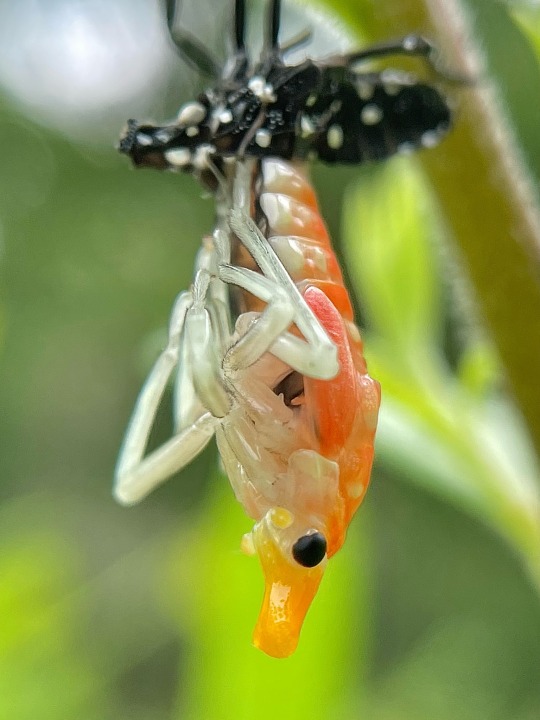
a good post on the topic of killing invasive species by @bowelfly :
804 notes
·
View notes
Text
Inktober Days 25-27
Day 25: Dangerous
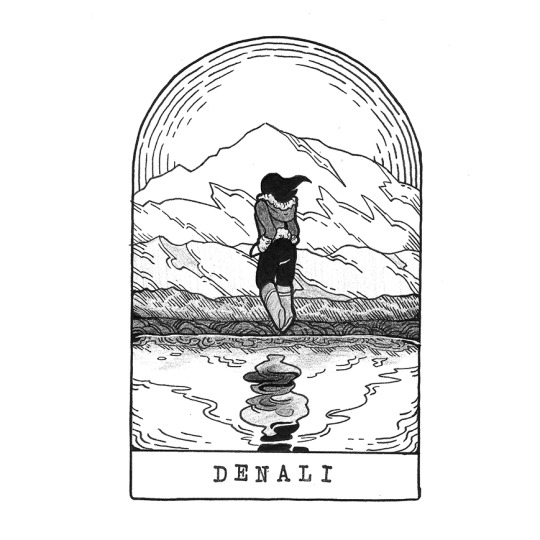
I don’t like this prompt. Every national park can be dangerous, and the deadliest places in parks, hands-down, are the roads, where drivers are distracted by wildlife and scenery. But if we’re going with pure statistics, excluding automobile accidents, then the most dangerous park, according to Backpacker Magazine, is Denali. The main cause of death is exposure, followed by falls. Despite what many folks might assume, there has only been one fatality caused by a bear in the park’s entire hundred-year-plus history.
National parks, overall, are pretty safe places. Park rangers work hard to keep them that way, trying to balance the wilderness experience with the health and safety of the visiting public. We implore folks to follow common safety measures in the backcountry and along the roadways, and there’s a whole facet of rangering called “PSAR”—preventative search and rescue. These folks are usually stationed at popular trailheads, checking that people have the proper gear, water, and footwear to successfully complete the hike. PSARs are your friends! Listen to the PSARs!
Day 26: Remove

When seasonals sit down for ranger training at the beginning of the summer, there’s one topic that we know we’re going to hear about, no matter which unit in the system we’re in. Invasive species. From lionfish to kudzu to emerald ash borers to toadflax, every park has its problem species that are taking over native ecosystems. Removal is a tricky, labor-intensive process—if they can be removed at all.
The Everglades are a prime spot for invasive species—they’re considered one of the most severely-infested parks in the system in terms of nonnative plants. The subtropical environment, combined with the famous issues of humans releasing exotic pets into the wild and planting exotic gardens, mean that some of these species can multiply rapidly with no natural checks and balances. Rangers work hard to keep invasives from destroying habitat needed by native plants and animals, but the truth is, in many cases the damage is done, and exotics are simply here to stay.
Day 27: Beast

How fortunate are we to share a continent with bison? Is there any animal more iconic of rolling American wilderness, or more representative of the sins and triumphs of our history? The bison is our national mammal, and the symbol on our ranger patch to represent the wildlife protected by the National Park Service.
Working in parks with bison, like Theodore Roosevelt, always creates an extra layer of excitement to the job. I’ve been late to work because of bison jams along roadways and had to physically move programs because bison were hanging out in the amphitheater. I once couldn’t take my trash out because a bison had bedded down just steps from my door. As a ranger, it’s easy to start thinking of bison as giant, bullheaded nuisances, but then you lock eyes with one outside your car window, and you remember—oh, this beast is the heartbeat of this landscape, my elder and my companion, and I’m dead privileged to wear her image on my chest.
------------
There's still a few more days left to preorder Thirty-One Days of National Parks: The Artbook!
91 notes
·
View notes
Text
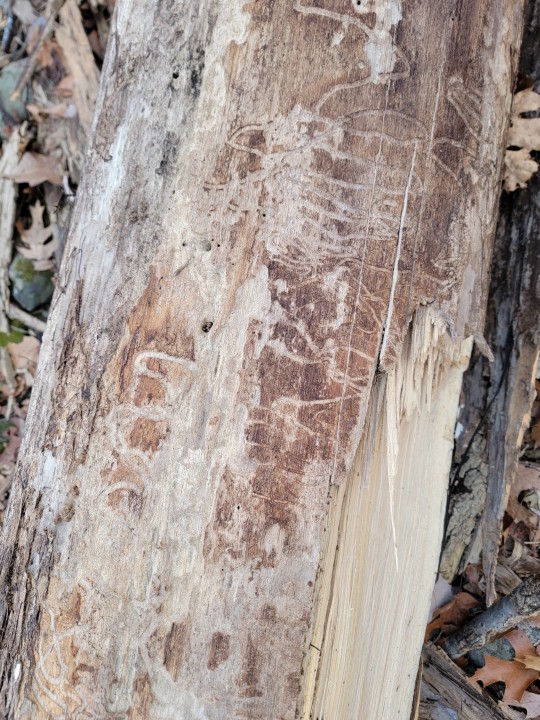



White Ash - Fraxinus pensylvanica
For this post I'm going to discuss the snags and reason I got back into ecology: The Ash Tree
Around the 1990s an insect from northeastern Asia was accidentally introduced to the Continental United States, by 2002 this insect was identified in Michigan after destroying several million acres of forest, this insect was the Emerald Ash Borer. The borer's larvae consume the living inner bark layer (leaving an interesting pattern), ultimately starving the tree of nutrients. The bark will often flake or peel off. By the year 2015, there were signs that the borer had spread to the east coast, its journey likely accelerated by the spread of firewood from infected logs, by 2019 nearly every mature Ash tree in Northern New Jersey was killed.
I grew up in a yard with twelve 150 year old Ash trees, the yard was adjacent to a section of Ash dominant forest, I watched the slow decline of all these trees, for half a decade I hoped our trees would be lucky enough to survive but unfortunately they all died within a few summers. Although the White Ash trees I encountered were wild from a 20th century clear-cut, they were a fairly common street tree around the northeast, straight growing, lovely bark and unfortunately most of the nursery stock was derived from a similar gene pool. There was little genetic diversity and many suburban neighborhoods were wiped of Ash trees. Many Ash trees were infested and look like the section of log I saved from my yard now (image below)

Suburban yards aside I quickly began to notice entire sections of forest filled with standing deadwood (image below). Worse yet white ash wasn't the only ash species affected, the entire genus is at risk. American Ash species often occupy a unique niche in cultivating young organisms which grow in vernal pools, the leaves of american ash are low in tannin, meaning they're one of the few leaves which are a suitable food source for young frog tadpoles. The loss of the ash means damage to American frog populations. It also means insects which utilized ash as a host are also at risk.
Ash also has quite a lovely ethnobotanical history, black ash is famous amoung various tribes around the northeast for its use in basket weaving. Historically Lenape elders would use the juice from white ash leaves for reducing swelling. More modern settler usages revolve around using the elastic yet study wood for baseball bats, oars, hockey sticks, and tool handles. My friends father used to raid his boss's construction sites at night to harvest ash slated for removal and deliver it to a baseball bat manufacturer for a decent payout. Ash also has a lovely grain visible in the broken log in the second image
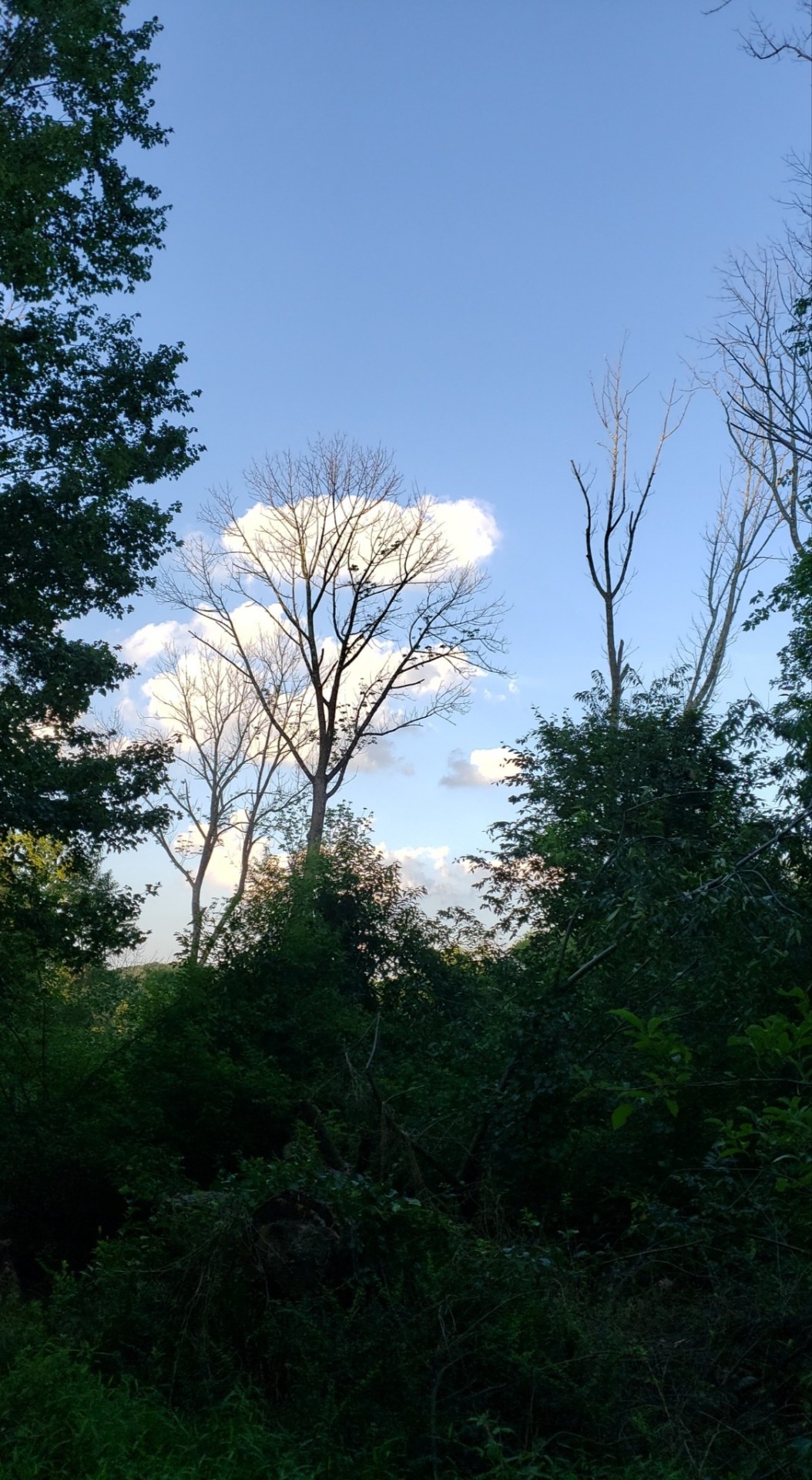
Ash forests now eerie snag filled openings which creak and occasionally fall on unsuspecting hikers. The thought of watching an entire forest ecosystem go really bothered me, ash swamps are unique, varied, there's something almost indescribable about growing up hearing early spring chirps from little tree frogs at night which are now silent. I left my job in architecture and started pursuing a degree related to landscape architecture and ecological planning (not that this is the answer). I started propagating ash trees where I could and planting them around. Unfortunately ash can't immediately return, invasive species often outcompete ash trees in their former forest, the added pressure ultimately reduces their ability to regenerate. The borer has spread so far there is little we can do to remove it, however there is a positive effect with biological control via the borers' specific parasitic wasp.
Is this the end of the ash? Hopefully not. I still find saplings throughout the woods, ash can be aggressive in the right conditions, can they survive into maturity is another question. Perhaps in another century, more will return, and ash will occupy our woods once more. Like the Chestnut work is being done to breed more resistant species.
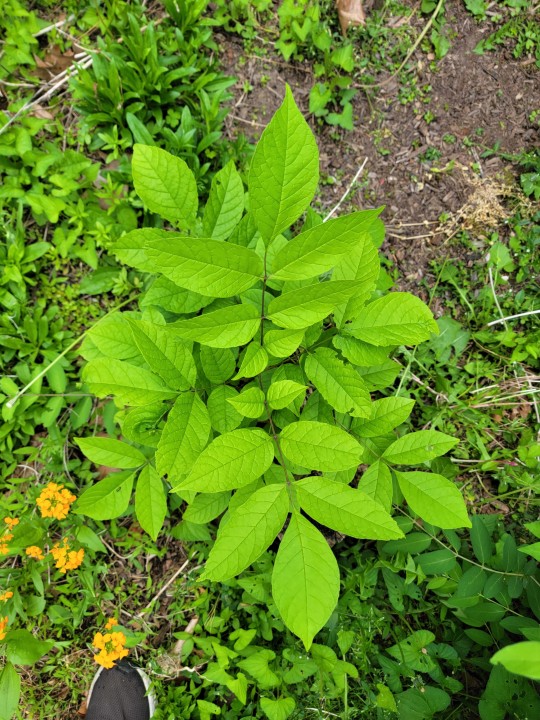
10 notes
·
View notes
Text
Why Is Pest Control Important?

Bug control is a vital part of keeping a well-balanced as well as safe atmosphere, whether it resides in property, business, or farming settings. Below are numerous factors why parasite control is crucial:
Wellness Problem
Insects like insects, rodents, cockroaches, as well as flies are companies of various illness as well as virus. These ailments can easily range from light health problems to extreme wellness ailments. For instance, bugs may send health conditions like jungle fever, dengue fever, and Zika infection, while rats can disseminate leptospirosis and also hantavirus. Effective -LRB-xx-RRB- steps assist to stop the spread of such illness as well as protect hygienics. For more information about Orlando pest control: go here.
Avoiding Residential Or Commercial Property Harm
Pests may create substantial damages to establishments, furnishings, and also various other possessions. Termites, for example, are known for harmful timber buildings, featuring furniture as well as the platform of buildings. Rodents can easily chew by means of electric cables, causing fires as well as other risks. By applying parasite control actions, building harm can be reduced or even protected against entirely, saving home owners as well as organizations from expensive repairs.
Maintaining Food Materials
In farming environments, pests can ruin crops, bring about substantial reductions in return and quality. Pests like insects, caterpillars, and also beetles can easily damage plants by eating fallen leaves, contains, and fruits. Mice as well as birds are actually likewise well known for damaging plants by consuming or even infecting all of them. Reliable Orlando exterminator in horticulture assists to shield food items supplies, ensuring an appropriate as well as safe meals resource for each people and also animals.
youtube
Maintaining Care
Pests are often attracted to regions with inadequate hygiene disorders, such as rubbish ditches, sewage systems, and inactive water. Cockroaches, for instance, prosper in grimy and also sweltering environments and also can spread out harmful micro-organisms and allergens. Flies are understood to multiply in decaying raw material as well as can easily broadcast conditions through infecting meals and also areas. Through executing appropriate sanitation practices as well as insect control steps, health specifications can be maintained, minimizing the threat of parasite infestations and also associated health condition.
Maintaining Ecosystem Balance
Some parasites, especially invasive species, can interrupt natural communities by outcompeting native varieties for information or even preying on all of them. This imbalance may have significant repercussions, impacting biodiversity, community security, as well as also individual source of incomes. For instance, invasive types like the Eastern longhorned beetle and also the emerald ash borer pose substantial hazards to forest ecosystems through damaging trees. Successful parasite control techniques, including biological control methods, are actually vital for preserving ecosystem equilibrium and shielding indigenous plants and animals.
Enhancing Lifestyle
Pest attacks can have a profound influence on the lifestyle of individuals as well as neighborhoods. The existence of insects can easily trigger stress and anxiety, worry, as well as soreness, impacting mental welfare and general happiness. Furthermore, the fear of getting conditions from pests can confine exterior tasks as well as social communications. By implementing positive Orlando exterminator solutions, communities may create more secure and even more pleasant residing environments for residents and site visitors equally.
To conclude, insect control is actually necessary for protecting public wellness, avoiding residential or commercial property damages, protecting meals items, preserving health specifications, preserving ecological community equilibrium, and also enhancing the quality of lifestyle. By addressing pest invasions promptly and successfully, individuals, companies, and federal governments can easily reduce the unpleasant impacts of pests and also produce far healthier, safer, and also even more sustainable atmospheres for every person.
All American Pest Control
390 N Orange Ave Suite #2300
Orlando, FL 32801
(321) 559-7378
Orlando Pest Control
0 notes
Text
When to Call a Tree Removal Service
When to Call a Tree Removal Service
https://ift.tt/IoSza41
Trees are an asset to any landscape and provide wind protection, homes for wildlife, and aesthetic beauty. However, they can also become a liability when their health or safety deteriorates to the point of becoming a hazard to people and property. While strategic pruning may be able to save an unhealthy or damaged tree, there are some instances when a full removal is the best option.
A few key indicators that it’s time to call a tree removal service include:
Dead or dying trees: It’s easy to identify if a tree is no longer alive. A lack of leaves, brittle branches, and dry, peeling bark are clear warning signs. If left untreated, a dead or dying tree can pose a fire hazard and be a danger to passersby.
Severe pest or disease infestation: A severe infestation can leave a tree in such a poor condition that it’s no longer viable. This is often the case with pests like the emerald ash borer that can devastate an entire city block of a once healthy and vibrant tree.
Root problems: Compromised roots are a sign that it’s time to remove a tree. These root systems can cause damage to sewer lines, driveways, and building foundations. They can even upend sidewalks and disrupt underground utility lines.
Trees too close for comfort
Whether it’s because of an overgrowth or improper planting, sometimes it becomes necessary to remove a tree that is growing too closely to a house or power line. Leaving a hazardous tree in its current position can lead to costly damage in the event it falls during a storm.
Before calling a tree removal service, it’s important to prep your yard. Make sure vehicles are out of the way and that breakable items, such as potted plants or lawn ornaments, are moved away from the area. You should also create two escape routes for yourself and your family in the event that the tree does fall. The primary path should be directly opposite of where the tree is expected to fall and the secondary route should be no more than 45 degrees from the primary path. This will give you enough time to safely escape the area should the tree fall in an unexpected direction. It is always a good idea to have an experienced tree professional inspect your yard before any work is done. They will be able to determine the most cost-effective solution for you and your home. Be sure to get quotes from multiple companies and compare each aspect of their services, including service fees, timelines, and included services. Look for a company that specializes in residential tree care, as they’ll have fewer city-mandated service restrictions and will be better equipped to handle the job. Lastly, make sure the company has proper insurance coverage before hiring them for any work. This will ensure your property and investment is protected.
0 notes
Text
Un coléoptère envahissant hautement destructeur qui tue les frênes a été découvert en Colombie-Britannique. C'est la première fois qu'il est officiellement recensé dans la province.
See on Scoop.it - EntomoNews
The small, invasive metallic green beetle bores into ash trees and damages the soft wood tissue that transports nutrients throughout the tree.
Beetle that destroys ash trees found in B.C. for 1st time
Tessa Vikander · CBC News ·
Posted: May 10, 2024 8:00 AM EDT | Last Updated: May 10
[Image] The emerald ash borer is an invasive beetle that has spread throughout regions of North America. Experts say the beetle is spread primarily through the transportation of firewood. (Government of Ontario)
------
NDÉ
Traduction
L'agrile du frêne se propage principalement par le transport de bois de chauffage.
Un coléoptère envahissant très destructeur qui tue les frênes a été découvert en Colombie-Britannique. C'est la première fois qu'il est officiellement recensé dans la province.
L'Agence canadienne d'inspection des aliments (ACIA) a récemment trouvé des larves de l'agrile du frêne à Vancouver, ce qui indique que l'insecte s'est déplacé vers la Colombie-Britannique à partir d'autres provinces.
Traduit avec DeepL.com (version gratuite)
0 notes
Text
Dangerous Trees: When to Remove and Replace
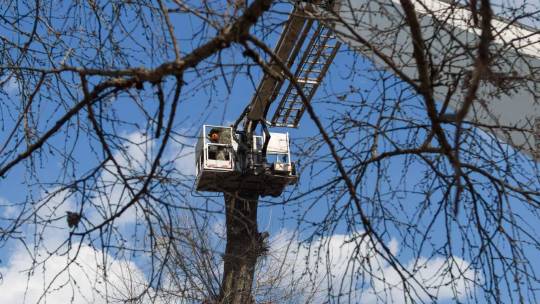
Trees can be wonderful assets to any landscape, providing shade, beauty, and environmental benefits. However, there are times when a tree can become a serious hazard and needs to be removed for safety reasons. Knowing when a tree has become dangerous and should be removed or replaced is an important part of responsible property maintenance.
One of the primary signs a tree has become dangerous is structural damage or decay. Trees can develop cracks, splits, or hollow areas in the trunk, branches, or root system over time. As a tree ages or sustains damage, these structural weaknesses make the tree much more likely to fail, potentially causing property damage or personal injury if it falls. Trained arborist can inspect trees and identify areas of structural concern.
Another warning sign is excessive leaning or an unstable base. Trees that are leaning at more than a 15 degree angle from vertical are at high risk of toppling, especially in high winds or storms. Likewise, trees with exposed, damaged, or decaying roots are more prone to uprooting. These trees should be removed before they fall and cause harm.
Disease and pest infestations can also compromise a tree's health and structural integrity to the point it becomes hazardous. Common issues like Dutch elm disease, emerald ash borer, or root rot fungi can spread through a tree's vascular system, gradually killing branches and the trunk. Infested or diseased trees that are in decline should be carefully monitored, and removed if they are no longer viable.
Of course, not all dangerous trees need to be completely removed. In some cases, regular professional pruning and maintenance can help mitigate the risks. Removing dead, damaged, or crossing branches and thinning out the canopy can go a long way toward improving a tree's structural stability and reducing the chances of failure. For trees with more advanced issues, however, full removal may be the safest course of action.
When a dangerous tree does need to be removed, it's important to hire a qualified, licensed arborist or tree care company to do the job properly and safely. Improper or amateur tree removal can lead to further property damage or personal injury. Professional arborists have the specialized equipment, training, and expertise to remove trees efficiently and minimize risks.
Once a dangerous tree removal Watertown SD, property owners should consider replacing it with a new, healthy tree that is appropriate for the site conditions. When selecting a replacement tree, it's wise to choose a species that is native to the local climate and has a track record of resilience. Fast-growing "volunteer" trees that spring up on their own are often less hardy and more prone to issues than carefully selected, nursery-grown replacements.
Maintaining the health and structural integrity of trees on your property is an important part of responsible ownership. By staying vigilant for signs of decay or instability, and taking prompt action to address dangerous trees, you can protect your home, your family, and your community from the risks of tree failure. With proper care and wise replacement choices, your property's trees can continue to be an asset for years to come.
Rugged Tree Service
507 829–4317
206 N Brook Ave, Porter Minnesota 56280
https://ruggedtreeservice.com/
Find Us: https://www.google.com/maps?cid=16359137231678289584
0 notes
Text
Spring Check up for Tree Care Should Include Emerald Ash Borer Inspection
Your trees have weathered the winter. With winter weather almost behind us and new buds popping up on trees, those trees may need special care to be their healthiest and most beautiful, particularly from emerald ash borer. The adult emerald ash borer (EAB) has been a significant and destructive pest in Pennsylvania for years. First discovered in the United States in 2002, the emerald ash borer has caused considerable damage to ash trees across the United States, affecting both the environment and the economy.
Because spring is the time that these adult beetles emerge and begin devouring the canopy of ash trees, we advise residents to be proactive and prepare to protect ash trees from this pest with a spring inspection of their trees.
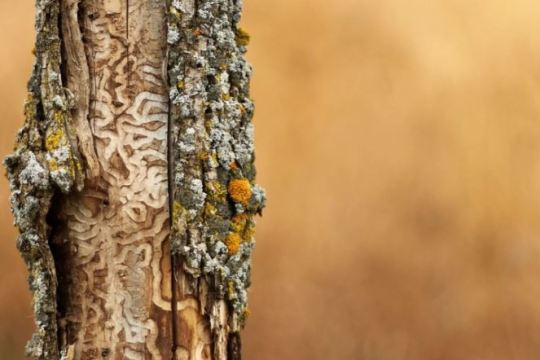
Tree Care Spring Checklist
Just like you do spring cleaning in your home, some tree maintenance should be done regularly for your trees to thrive. To help you keep your trees safe, here is a checklist of what to do to maintain the health and appearance of your trees from the impact of emerald ash borer.
Inspect Your Trees Thoroughly
The adult emerald ash borer emerges in spring, but you should be on the lookout for them all year, as larvae activity damage can be seen when the trees are bare in winter. Start from your driveway and look at the landscape as a whole. You may see trees that are growing irregularly, thin areas in the canopy, fungal growths, or other issues that might get missed by a daily casual glance.
Look For Signs of Emerald Ash Borer Activity
Generally, the first major sign that EAB has infested a tree is a thinning of leaves at the top of the tree. Unfortunately, if you see this symptom, your tree will likely have been under attack for some time already. Other signs to look for include the following:
Yellowing of leaves
Epicormic shoots
D-shaped exit holes
S-shaped galleries under the bark
Unusual woodpecker activity
Remove Debris & Tree Wrappings
Regular fall and winter seasons will cause leaves to cover the areas around the base of your trees. After the winter season we have just encountered, you may find larger branches that need to be removed. Rake or pick up leaves, twigs, or other debris around your trees.
Also, remove any protective wraps you have used during the winter and ensure that no roots or other items are wrapped around the trees. Leaving the tree constricted in any way can cause girdling, which cuts off the flow of nutrients and water and can weaken the tree trunk.
Add Fresh Mulch
In addition to giving a fresh look to your landscape, mulch can be a healthy addition. Adding a 3-inch layer of mulch around trees helps retain moisture and discourages weed growth. Be careful to avoid mulching too close to the tree. If mulch piles against the tree, fungi are more likely to develop, so make sure the mulch is all around the tree but just shy of touching the tree.
Trim and Prune
Though winter is the best time for pruning, trees may remain dormant in spring, allowing for late trimming and pruning. Remember that in Pennsylvania and Delaware, windy conditions and storms are common in the spring and summer, so thinning out branches will reduce the potential for weak branches to fall off and cause damage to surrounding property. Pruning trees and shrubs can help with overall air flow and also encourage healthy growth.
However, pruning requires the right knowledge and experience, as improper or incorrect cuts can lead to adverse outcomes, like over-pruning or improperly pruning, damaging the appearance or overall health of the trees. As a result, hiring a professional to do this type of pruning is recommended.
General Inspection Tips
In addition to our specific recommendations, here is some general advice when looking at your landscape in the spring.
Inspect all elements of your landscape to prepare for the summer.
Ensure irrigation systems are working properly and set to avoid spraying on trees susceptible to fungus.
Check for any damage that may have occurred. If tree limbs are weak, those branches may be susceptible to breakage, which could cause property damage. Damage to bark could also leave trees open to infection or insect infestation.
Look for the presence of fungus or other tree disease. Mushrooms growing on tree surfaces could indicate tree death, weakening the tree trunk and necessitating removal.
Call Stein Tree for Spring Tree Care and Emerald Ash Borer Inspection
Maintaining your landscape should be essential to your home spring cleaning routine. Stein Tree Service has provided excellent tree care, including tree removal, trimming and pruning, emerald ash borer inspection, and other services, to the residents of Delaware, Pennsylvania, and Maryland for over 40 years. We are also licensed to treat the emerald ash borer pest in Delaware and Pennsylvania. Contact us today for a free consultation or to learn about our services!
Blog is originally published at: https://www.steintree.com/spring-check-tree-care-include-emerald-ash-borer-inspection/
It is republished with the permission from the author.
0 notes
Text
Emerald Ash Borer confirmed in Northern Iowa's Palo Alto county
DES MOINES – The United States Department of Agriculture (USDA) Animal and Plant Health Inspection Service (APHIS) has confirmed the presence of the emerald ash borer (EAB) in Palo Alto County for the first time. Insect samples were collected in March from an ash tree in Basswood Recreation Area outside of Emmetsburg. Department staff noticed woodpecker damage in an ash tree, which is a symptom…

View On WordPress
0 notes
Text
Winter can uncover signs of emerald ash borer
The emerald ash borer, an invasive insect, is the most damaging threat to Wisconsin trees. The bug kills more than 99 percent of the untreated ash trees it infests.
By Mallory Cheng
Winter is a time when we can more easily spot the infested ash trees.
The emerald ash borer, an invasive insect, is the most damaging threat to Wisconsin trees. The bug kills more than 99 percent of the untreated ash trees it infests.
Bill McNee is a forest health specialist at the Department of Natural Resources. He explained how to look for infected trees with “All Things…

View On WordPress
0 notes
Text
9 Reasons When Tree Removal Services Become Essential

Hey there, fellow tree enthusiasts! Today, we will dive deep into the world of tree removal services. You might be wondering, "Why is tree removal so important?" Well, my friend, let me tell you that there are numerous reasons why tree removal Croydon services become essential in certain situations.
From safety concerns to overgrown trees, disease and infestation to storm damage, property development to leaning or unstable trees, root damage to dead trees and stumps, and even the importance of tree replacement – we've got it all covered.
So, grab a cup of coffee, sit back, and explore the nine reasons tree removal services become essential.
1. Safety Concerns
When it comes to trees, safety should always be a top priority. Trees, especially those dead, diseased, or damaged, can pose significant risks to people and property. A dead tree, for instance, can quickly become a falling hazard during strong winds or storms. Additionally, diseased or damaged trees may have weakened branches that could potentially break and cause injury or property damage. Professional tree removal Croydon services are necessary to ensure everyone's safety. These experts have the knowledge, skills, and equipment to remove hazardous trees safely and efficiently, minimising potential risks.
2. Overgrown Trees
While trees are a wonderful addition to any landscape, they can sometimes become a nuisance when they grow too large and overtake their surroundings. Overgrown trees can obstruct views, block sunlight, or damage nearby structures. In worst-case scenarios, they can interfere with power lines, leading to power outages or dangerous situations. In such cases, tree removal Croydon services can effectively address these issues. By carefully removing the overgrown trees, the landscape can be restored to its former glory, allowing for better views, increased sunlight, and reduced risk of damage.
3. Disease and Infestation
Like humans, trees can also fall victim to various diseases and infestations. Common ailments such as Dutch Elm Disease, Oak Wilt, or Pine Wilt can wreak havoc on tree populations if left untreated. Additionally, pests like the Emerald Ash Borer or Gypsy Moth can cause significant damage to tree health. If these diseases or infestations are not promptly treated, they can spread to other healthy trees, leading to a decline in overall tree health. In such cases, tree removal is crucial in preventing further infestation and disease spread. Removing the affected trees significantly reduces the potential for spreading these issues to healthy trees.
4. Storm Damage
Severe weather conditions, such as storms or hurricanes, can have a devastating impact on trees. Strong winds can uproot or break branches, causing damage to nearby property or posing a threat to human safety. In the aftermath of a storm, it is essential to call upon professional tree removal services to assess the damage and remove any fallen or damaged trees. This prevents accidents and further property damage and allows for the cleanup and restoration of the affected area.
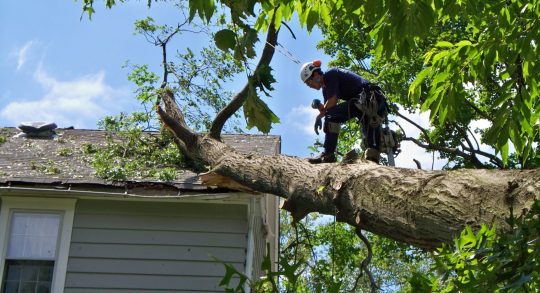
5. Property Development
Tree removal sometimes becomes necessary for property development or construction projects. While this may seem unfortunate, there are times when it is essential for progress. However, it is important to note that preserving some trees is highly desirable for ecological or aesthetic reasons. In such cases, tree removal services can work hand in hand with property developers to identify which trees can be safely preserved and which need to be removed to make way for the project. This ensures a balanced approach that respects both nature and development.
6. Leaning or Unstable Trees
Have you ever come across a tree that seems to be leaning precariously or appears to be unstable? Well, my friend, that tree is a potential accident waiting to happen. Leaning or unstable trees pose a significant risk to people and property. These trees can fall unexpectedly due to root issues, age, or external factors, causing severe damage or injury. To prevent any potential accidents, calling upon professional tree removal services is crucial. These experts can safely and efficiently remove the leaning or unstable trees, ensuring the safety of the surrounding area.
7. Root Damage
Sometimes, the stability of a tree can be compromised due to root damage. Root damage can occur for various reasons, such as construction, excavation, or disease. When the stability of a tree is compromised, it can pose a risk to nearby structures and the tree itself. In such cases, addressing root damage often involves removing the affected tree. Professional tree removal services can assess the situation, determine the extent of the root damage, and safely remove the tree if necessary. By taking prompt action, further damage to the tree and its surroundings can be prevented.
8. Dead Trees and Stumps
Dead trees, with their bare branches and lack of foliage, are unattractive and pose potential hazards. These trees can easily become a falling hazard during storms or strong winds, putting people and property at risk. Additionally, the presence of dead trees can detract from the overall aesthetic appeal of a landscape. It is important to remove dead trees promptly to minimise potential risks and improve the area's visual appeal.
Along with removing dead trees, stump removal is also essential. Stumps can be a tripping hazard and lead to future tree growth. By removing the stumps, safety is improved, aesthetics are enhanced, and the prevention of future tree growth is ensured.
9. Tree Replacement
While tree removal is sometimes necessary, replacing the removed trees with new ones is equally important. Planting suitable tree species helps to maintain the ecological balance and improve local environments. Trees provide numerous benefits, including shade, oxygen production, and habitat for wildlife. By replacing removed trees, we can continue to enjoy these benefits while ensuring a healthy and vibrant ecosystem for future generations. So, after removing a tree, don't forget to plant a new one in its place!
Conclusion
Phew! We've covered a lot in this detailed blog on the nine reasons tree removal services become essential. We've explored everything from safety concerns to overgrown trees, disease and infestation to storm damage, property development to leaning or unstable trees, root damage to dead trees and stumps, and even the importance of tree replacement. Remember, professional tree removal Croydon services are crucial in ensuring the safety of people and property, maintaining the health of trees and ecosystems, and enhancing the overall aesthetics of our surroundings. So, the next time you encounter a situation that calls for tree removal, don't hesitate to call the experts.
Source: https://rangeviewtreeservices.godaddysites.com/f/9-reasons-when-tree-removal-services-become-essential
0 notes
Text
Emerald Ash Borer: A Threat to Pennsylvania’s Ash Trees
In this third installment of our series on invasive species of insects, we will discuss the emerald ash borer (EAB). This invasive woodboring beetle has wreaked havoc on ash tree populations in Pennsylvania and other states in the United States and other regions in North America. As a homeowner, you should understand the impact of this invasive pest. Below, we discuss the characteristics, life cycle, and damage caused by emerald ash borer in Pennsylvania as well as some prevention and treatment methods.
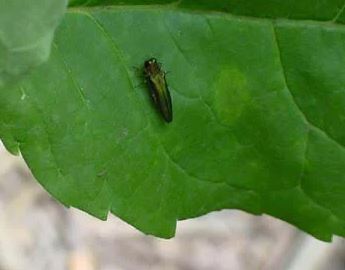
What Is the Emerald Ash Borer?
The emerald ash borer (Agrilus planipennis) is a small, metallic green species of beetle native to northeastern Asia that has become invasive to North America. The beetle was first discovered in the United States in 2002 in Michigan and has since spread to 30 states, including Pennsylvania. EAB attacks and kills ash trees in North America by feeding on their inner bark, disrupting the tree’s ability to transport water and nutrients.
Emerald Ash Borer Appearance
Adult EAB are distinguished by their bright metallic green color and are approximately 1/3 of an inch (8.5 mm) long and about 1/16 of an inch (1.6 mm) wide. Females are also slightly larger than males. The elytra (hard shells that serve as protective cases for wings) are typically a darker green but can also have copper hues. Another distinguishing feature of the adult emerald ash borer species is its bright red upper abdomen that can be seen when the wings and elytra spread.
Larvae are white to cream-colored with 10 abdominal segments. The last segment has a pair of brown, pincer-like appendages. Larvae typically reach a length of 1 to 1¼ inches.
Emerald Ash Borer Life Cycle
The emerald ash borer has a 1-year life cycle. Adult beetles emerge through D-shaped exit holes in a tree around late May and early June—adult activity peaks between mid-June and early July. After appearing, the adult beetles feed on ash foliage for several days and then begin to mate. Females lay approximately 60-90 eggs in their lifespan, which hatch in 7 to 10 days.
After hatching, the larvae tunnel through the bark into the ash tree’s phloem (plant tissue). Larvae feed on phloem for several weeks, creating S-shaped paths in the tree under the bark. As larvae grow, these galleries become progressively wider. Prepupal larvae overwinter in shallow chambers within the bark. Pupation begins in late April or early May and lasts 1 to 2 weeks when this species’ life cycle starts again.
Signs and Symptoms
If you have ash trees on your property, knowing the signs and symptoms of EAB infestation is crucial to keeping them safe and preventing damage. These signs include the following:
Thinning canopy and dieback of branches
D-shaped exit holes in the ash tree bark
S-shaped galleries under the bark
Increased woodpecker activity (as woodpeckers feed on larvae)
Damage from Emerald Ash Borer
As mentioned above, EAB larvae feed on the nutrient-rich inner phloem, cambium, and outer xylem beneath the bark, creating S-shaped galleries packed with sawdust-like frass. As the infestation of this invasive species progresses, the symptoms mentioned above become more apparent. Trees will die after 3 to 4 years of heavy infestation, making EAB control tactics crucial to preserving ash tree populations.
Preventing Emerald Ash Borer Infestation
Prevention is the best way to avoid damage, and there are several steps you can take to protect your ash trees from EAB:
Do not move firewood: Moving firewood can inadvertently transport EAB to new locations. Some states, including Pennsylvania, have restrictions on moving firewood because of invasive insect species. Always buy firewood locally and burn on-site.
Use insecticides: Preventive insecticides containing certain ingredients and agents can be applied to healthy ash trees to protect them from EAB. Consult a certified arborist for advice on the appropriate insecticides and application methods.
Plant diverse tree species: Planting a variety of tree species can help reduce the impact of EAB on your property and promote a healthier ecosystem.
Damage from Emerald Ash Borer
As mentioned above, EAB larvae feed on the nutrient-rich inner phloem, cambium, and outer xylem beneath the bark, creating S-shaped galleries packed with sawdust-like frass. As the infestation of this invasive species progresses, the symptoms mentioned above become more apparent. Trees will die after 3 to 4 years of heavy infestation, making EAB control tactics crucial to preserving ash tree populations.
Treating EAB Infestation
If your ash trees are already infested with EAB, Burkholder PHC offers various treatment options, including:
Insecticide: Treatments can be applied to infested trees to kill EAB larvae and prevent further damage. Some application options include soil drenches, soil injections, or stem injections.
Tree Removal: In some cases, infested trees may need to be removed to prevent the spread of EAB to nearby healthy trees.
Replacement Planting: After removing infested trees, consider planting a diverse selection of tree species to help restore the ecosystem.
Contact Burkholder PHC for Emerald Ash Borer Treatment in Your Landscape
If you suspect or are concerned about emerald ash borer impacting your property, contact Burkholder PHC for expert advice and treatment options. We provide a free evaluation by our highly experienced, qualified plant health care experts and certified arborists to help remove and control invasive species and the adverse effects these pests cause. Contact Burkholder PHC today for a free consultation or more emerald ash borer information.
Blog is originally published at: https://www.burkholderphc.com/emerald-ash-borer-a-threat-to-pennsylvanias-ash-trees/
It is republished with the permission from the author.
0 notes
Text
Tips for Keeping Your Trees Healthy in the West Island
Trees are an integral part of our ecosystem and play a crucial role in maintaining the balance of nature. They aesthetically enhance the curb appeal of our homes and provide shade and privacy, thus making them a valuable asset. It only makes sense for us to take proper care of them. If you live in the West Island, you know that there are many challenges associated with tree health care. However, with the right knowledge and care, you can ensure that your trees thrive and remain healthy. In this blog post, we will share valuable tips for keeping your tree health care in the West Island.
1) Pruning And Trimming:
Pruning and trimming should be done regularly to maintain the health of your trees. It helps to remove diseased and damaged branches and encourages new growth. It also helps to promote air circulation, which is essential for healthy growth. It is essential to hire professional tree care services in West Island to ensure that the pruning and trimming are done correctly.
2) Watering and Soil:
One of the biggest challenges in maintaining healthy trees in the West Island is drought. Providing sufficient water is crucial for the survival of trees, especially during the summer months. The soil in West Island is usually clay-based, which makes it challenging for water to penetrate deep into the roots. Adding mulch around the trees helps to retain moisture and suppress weeds. It is also essential to ensure that there is proper drainage to prevent waterlogging.
3) Pest Control:
Pests and diseases can cause significant damage to trees. Common pests in the West Island include emerald ash borers and gypsy moth caterpillars. Professional tree care services in West Island can provide pest control measures using organic or chemical methods. It is important to identify and treat pest infestations early to prevent the spread of damage.
4) Tree Health Assessment:
Regular tree assessments are essential to identify any potential problems early. It helps to identify issues such as structural damage, root issues, and pest infestations. Tree assessments should be carried out by professional tree care services, as they have the necessary experience and training to identify issues that may not be obvious to the untrained eye.
5) Fertilization:
Fertilization is essential for the healthy growth of trees. The soil in West Island may not have sufficient nutrients required for healthy growth. Fertilizers can replace lacking nutrients and improve the overall health of the trees. Fertilizers should be applied during the early spring or fall to ensure that the tree can absorb the nutrients.
Conclusion:
Trees are a valuable asset to our environment and homes. Proper care and maintenance are essential to ensure that they thrive and remain healthy. Regular pruning and trimming, watering and soil management, pest control, tree health assessments, and fertilization are some of the essential tips for keeping tree health care in the West Island. It is important to hire professional tree care services in West Island to ensure that the tips are carried out correctly. Following these tips can help to keep your trees in excellent health and condition for years to come.
#Tree Trimming West Island#Tree Removal West Island#Tree Cutting Services West Island#West Island Tree and Hedge Experts
0 notes
Text
The Hidden Threat to Your Home: Understanding the Life Cycle of Wood Boring Beetles
If you notice holes in tree trunk and branches, there can be an infestation of a wood boring beetle. Tree borers are small insects that burrow into trees, causing severe damage to the tree’s structure and health. These pests are difficult to control and can quickly destroy a tree if left unchecked.
Tree borers are a type of beetle that feeds on wood. There are several different types of borers, each causing damage in a different way.
The most common wood boring beetles include the powder post beetle, furniture beetle, and house borer. These pests feed on the sapwood of hardwoods and softwoods alike, creating tunnels that weaken the tree’s structure and decrease its overall health.
Tree borers can cause significant damage to trees by feeding on the wood and disrupting normal tree functions. These pests may also lay eggs inside the tree’s trunk, causing further damage and weakening the tree’s structure. Tree borers typically attack trees that are already weakened or stressed, which can make the tree more susceptible to disease and other problems. So, tree borer treatment from professionals becomes crucial.
Identify The Species Of Wood Boring Beetles
There are many different species of wood boring beetles, each with its own set of characteristics and behaviors. Some common species of tree borers include the emerald ash borer, the flat-headed apple tree borer, and the bronze birch borer.
Emerald ash borer beetles are small, metallic green insects that typically measure between 1/8 and 1/2 inches in length. These pests are native to Asia and were first discovered in the United States in 2002. Emerald ash borers feed on the wood of ash trees, causing severe damage to the tree’s structure and health.
Flat-headed apple tree borers are another common type of wood boring beetle. These pests are small, brown insects that measure 1/3 to 3/4 inches in length. Flat-headed apple tree borers feed on the wood of the apple, mulberry, and other trees, causing extensive damage to the tree’s structure and health.
Bronze birch borers are small, bronze-colored insects that measure 1/8 to 1/2 inches in length. These pests feed on the wood of birch trees, causing severe damage to the tree’s structure and health. If left unchecked, bronze birch borers can quickly kill a tree.
While each type of wood boring beetle presents its own challenges, all types of tree borers have the potential to cause significant damage. You offer accurate tree borer treatment as soon as possible to minimize the risk of severe infestation. To prevent re-infestation, it is crucial to inspect trees regularly for signs of damage and treat any infested wood in your landscape. Additionally, it is vital to maintain healthy trees by providing proper nutrition and care. With careful monitoring and maintenance, you can protect your trees from severe wood boring beetle damage.
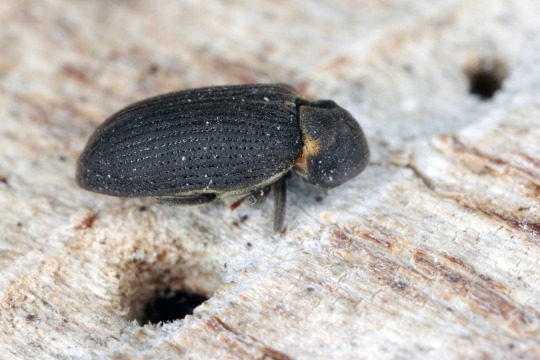
Biology And Habits Of Wood Boring Beetles
Most wood boring beetles go through a complete metamorphosis, meaning they have an egg, larval, pupal, and adult stage. The time it takes to go from egg to adult can vary based on species and temperature but is generally between 2 months and 2 years.
The female beetle will lay her eggs on or near the host tree, where they will hatch and feed on the tree’s soft inner bark. During this phase of development, the larvae may also bore into the tree’s sapwood or heartwood. After reaching adulthood, the beetles will leave their host tree to mate and reproduce.
Woodboring beetles are notorious for causing significant damage to trees and other wooden structures. These pests bore into the wood of their host tree, causing extensive damage to the tree’s vigor and health. In some cases, woodboring beetles can completely destroy a tree. Additionally, these pests may also vector diseases that can further damage or kill the tree.
Wood boring beetles are often complex to control once they have infested a tree or other wooden structure. So, how to get rid of wood boring beetles? Well, to prevent significant infestation, it is essential to regularly inspect trees and other wooded areas for signs of damage and to treat any affected areas as soon as possible. Additionally, maintaining healthy trees by providing proper nutrition and care can help reduce the risk of severe damage caused by wood boring beetles. With careful monitoring and maintenance, you can protect your trees and other wooden structures from the destructive effects of wood boring beetles.
Signs Indicating Wood Boring Beetle Infestation
There are several signs that can indicate a wood boring beetle infestation, including:
Presence of small holes or tunnels in the tree’s bark or wood
Visible sawdust or frass near the tree’s base
Damaged or dying branches or leaves
Discoloration or decay of the tree’s wood
Holes in the bark of the tree for exit routes
Bark that is peeling or cracked
Larvae or adults crawling on the tree or the ground nearby
If you see any of these signs of wood boring beetle infestation on your trees or other wooden structures, take immediate action to treat the affected areas and protect your trees. With regular monitoring and prompt tree borer treatment, you can help minimize the risk of severe damage caused by wood boring beetles.
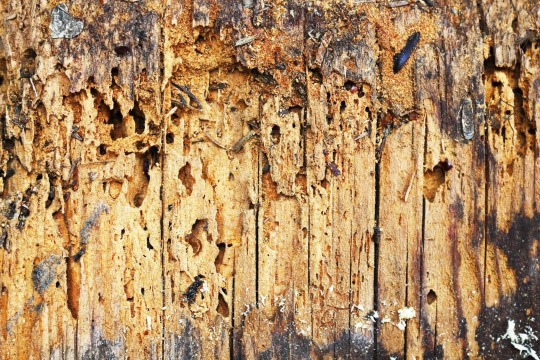
How to Get Rid of Wood Boring Beetles?
There are several options for treating wood boring beetle infestations. The best course of action will depend on the severity of the infestation and the type of beetle involved. Some common treatment options include:
Treat and care infested wood
Apply chemical insecticides to the affected area
Encourage natural predators, such as woodpeckers, to feed on the beetles
Accurate treatment of infested trees
Apply biologically-based insecticides to the affected area
Trunk and soil injection to restrict the growth of the beetles
With prompt treatment, you can help prevent wood boring beetles from causing extensive damage to your trees and other wooden structures. For more information and tips on how to get rid of wood boring beetles infestation, talk to our professional arborist or pest control expert.
Ways to Prevent and Control Wood Boring Beetles
Several steps can be taken to prevent and control wood boring beetles. These include:
Inspecting trees and other wooden structures regularly for signs of infestation, such as holes or tunnels in the bark, frass, or sawdust near the base of the tree, damaged or dying leaves and branches, etc.
Treating infested areas promptly with chemical or biological insecticides
Encouraging natural predators, such as woodpeckers, to feed on the beetles
Injection to trunk and soil to limit the growth of beetles
Maintaining the health of trees by providing proper tree nutrition and care.
By taking these steps, you can help reduce the risk of wood boring beetle infestation and the damage they can cause.
Takeaways
Wood boring beetles are often difficult to control once they have infested a tree or other wooden structure. To prevent significant infestation, it is crucial to regularly inspect trees and other wooded areas for signs of damage and to treat any affected areas as soon as possible.
There are several signs that can indicate a wood boring beetle infestation, including visible sawdust or frass near the tree’s base, damaged or dying branches or leaves, and exit holes in the bark.
Some common treatment methods for wood boring beetle infestations include treating and caring for infested wood, applying chemical insecticides accurately to affected areas, and maintaining health with balanced nutrition. The wood boring beetle treatment cost will vary depending on the severity of the infestation and the type of beetle involved. However, offering tailored treatment to wood boring beetle is crucial.
Original Source: All You Need to Know About Wood Boring Beetles
0 notes
Text
When Tree Removal Is Necessary
When Tree Removal Is Necessary
https://ift.tt/P4NusDi
Trees are not only beautiful and a source of comfort, they’re Mother Nature’s masterpieces in our own backyard. However, sometimes they can become hazards that need to be removed. If a tree is damaged or dead, it can fall on your house, power lines, or other structures on your property and cause significant damage.
If a tree is in a hazardous location, it is likely best to remove it with the help of a professional crew that specializes in this type of work. Hiring a crew is more expensive than taking on a DIY project yourself, but the cost of repairing your home or paying medical bills due to injury can easily outweigh any savings from doing it yourself.
The first step an arborist takes when assessing a tree for removal is thoroughly examining it. They consider the height, canopy size, and the location of any power lines or other structures. They also assess the tree’s overall condition, identifying the level of risk it poses to people and property.
A tree’s root system is typically twice as wide as its crown, so it can be extremely dangerous to plant a tree too close to your home. The roots may start to grow into sewer lines or even crack the foundation of your home, which can be extremely costly to fix. In addition, trees planted too close to homes may suffer from storm damage and potentially collapse in high winds.
Another common reason to remove a tree is if it is in the way of a sidewalk, driveway, or building. Some people choose to remove a tree when it begins to overshadow their home and block out sunlight. Others want to reclaim the yard space for other uses, such as gardens or outdoor seating areas.
If a tree is displaying signs of disease, such as wilting leaves, bark peeling, and insect infestations, it’s likely time to call an arborist for evaluation. Infestations with pests, like the emerald ash borer, can lead to the rapid decline of a tree and should be addressed immediately.
It is also possible for a tree to require removal if it has lost a large number of branches or limbs. These can be caused by disease, storm damage, or improper pruning techniques. In addition, if a tree is losing branches at an accelerated rate and becoming overcrowded, it may need to be removed to allow for healthier and more attractive growth.
It’s important to create two clear paths of exit in the event of a tree failure. A primary path should be in the direction the tree is expected to fall, and a secondary path should be at least 45 degrees away from the primary route. It is also a good idea to move any outdoor furniture, vehicles, fire pits, and other lawn accessories that could be harmed by falling limbs or debris. Lastly, it’s recommended to wear protective eyewear when performing any tree work. This includes a pair of safety goggles or a helmet with face protection, as well as heavy-duty gloves and long-sleeved clothing to protect yourself from twigs, branches, and other debris that might fall.
0 notes